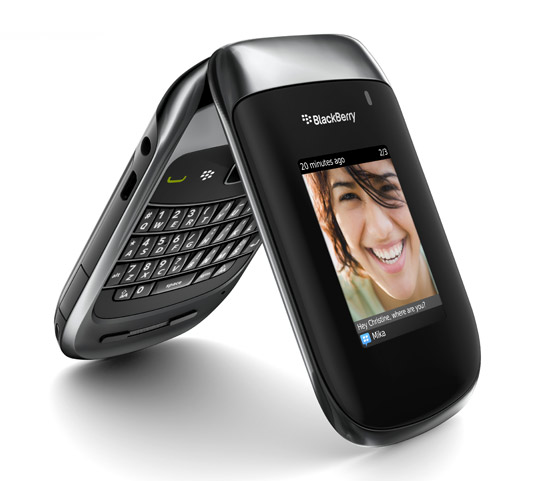RIM unveils BlackBerry Style 9670; is this full QWERTY flip 'fresh' and 'approachable'?

If you took every BlackBerry on the market today and mashed them into one device what would it look like?
Chances are a lot like RIM's new BlackBerry Style 9670.
The Canadian smartphone maker announced on Monday the device, its first with both a full-QWERTY keyboard and a flip form factor.
Something must be in the water in Waterloo, because this device is a doozy. It packs dual high resolution displays, the BlackBerry 6 operating system (yes, that means a WebKit browser), a five-megapixel camera (flash, autofocus, video capability), GPS, 802.11 b/g/n Wi-Fi, 512MB memory (microSD expandable to 32GB) and displays with 240 by 320 and 360 by 400-pixel resolutions.
It arrives on Sprint on Oct. 31 for $99.99 ($100 mail-in rebate) with a two-year contract.
The question, of course: will it blend?
The device is no doubt targeted to the broader (read: new smartphone users and teenagers) market -- aside from the clamshell form factor, it comes in "fashionable" purple and gray colors and its being framed as an "elegant" messaging phone with "integrated social feeds" and "enhanced multimedia features."
Now, I'm no 14-year-old -- if I was, I'd feel lucky as hell to have a smartphone, let me tell you -- but it seems to me that this attempt to woo this market is misplaced.
Blackberrys, of course, took off with younger folks and the broader market in the mid-2000s. The BlackBerry Pearl, which debuted in 2006, was one example of a growing mass of teenagers using these newfangled "smartphones," which could access the Internet and maps and all sorts of great stuff on the go.
For years, the trend confused business customers who long used BlackBerrys -- why on Earth would a teenager use a business device? -- but it's now clear that younger folks wanted the connectivity, and simply didn't have a device to satisfy that demand. (Perspective: one year later, the Apple iPhone was released. Two years later, the T-Mobile G1 was released.)
Now, in 2010 (almost 2011!), smartphones are rapidly gaining traction in the U.S. market. We're on the fourth iteration of the iPhone. The Palm Pre has come and gone. And there are enough Android handsets to fill a small nation.
Until now, RIM's BlackBerry devices have been a trusty standby and backbone to the market. They had first mover's advantage, and hooked a lot of folks long before any talk of "apps." They've changed in some ways -- the Storm went touch and the new Torch straddles the fence -- but until recently, consumers had a backseat to RIM's lucrative enterprise market.
In response, teenagers gravitated toward more palatable devices -- the pricey but iconic iPhone, approachable and easily accessible second-tier Android handsets such as Motorola's Cliq and HTC's Droid Eris, et cetera -- and left RIM in the dust. After all, why buy a clunky business device in the golden age of the consumer smartphone?
(For those pointing out how RIM's market share has defied my "left in the dust" description, consider that Verizon first initiated unit-driving Buy One, Get One promotions using RIM's devices.)
The Style is RIM's attempt at trying to attract this market once more, but the company is using an old playbook. (No pun intended with regard to its tablet device.)
It's clear that RIM thinks its full QWERTY keyboard is great to use for a messaging device, but those devices are being replaced by touchscreen models (that have physical keyboards as well).
The flip phone has also come and gone, because photos, video and all that touching and poking require bigger screens for fingertips.
The Style is repackaging older technology. That's fine for a $99 device, but not for a platform that needs not to be in a holding pattern but gaining users.
In a way, the Style is just a Band-aid for a larger problem: despite recent moves to close the gap, the BlackBerry is still fundamentally not a consumer device.
A touchpad won't satiate those conditioned to use touchscreens. (I imagine lots of fruitless screen poking in the store.)
An App World is no place for those familiar with an App Store. ("What's Bloomberg?" I imagine one target consumer asking.)
And pictures just don't look as good on that tiny display.
I'm not trying to bash the BlackBerry, of course -- I'm just trying to put this into perspective. Said a different way: "BlackBerry Enterprise Server" is not on the tips of the tongues of RIM's target audience for the Style.
I'm sure some folks will buy this device, and I'm sure it's a fine device in its own right -- my judgment is only based on the device's announcement.
But marketing is everything, and from what I've seen, the Style is far too half-hearted an attempt to help propel RIM back to the front of the pack. It's just not enough.
To appeal to that person, you've got to commit. You've got to understand their wants. You've got to get deep inside in their head. And something tells me that there's no monochromatic analog clock in there -- even if it's got a tiny Facebook icon beneath it.
